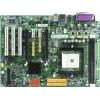Wednesday, January 10, 2007

LATEST AMD MOTHERBOARD
All eyes may be on Opteron, but AMD's bread and butter is still the Athlon XP line of processors. Will the increase to a 400MHz frontside bus help the struggling CPU maker keep pace with Intel's blistering pace on the desktop? We run our battery of tests and find both good news and bad news. We also see Nvidia's new Nforce2 Ultra 400 in action.

Many motherboards offer Ethernet, USB 2.0, and FireWire ports. USB 2.0 is much faster than USB 1.1. USB 2.0 supports higher-bandwidth devices, such as cameras, video conference cameras, fast storage units and next-generation scanners. Most motherboards today, ship without PS/2, serial, and parallel ports which are used to connect older mouse parallel printers and older keyboards.

LATEST INTEL MOTHERBOARD
Pentium 4 and Athlon XP are the two main choices for CPUs. Motherboard vendors sometimes list their boards by the type of socket that accommodates the CPU. For example:
Socket 478 - for older Pentium and Celeron processors
Socket 754 - for AMD Sempron and some AMD Athlon processors
Socket 939 - for newer and faster AMD Athlon processors
Socket A - for older AMD Athlon processors
Currently socket arrangements are often named after the number of pins in the Pin Grid Array (PGA). The newest Intel CPU does not have a PGA. It has a Land Grid Array (LGA), also known as Socket T. A LGA is different from a PGA in that the pins are actually part of the socket and not the CPU. If you want to use one of the new multi-core chips made by Intel or AMD, choose a motherboard with the correct socket for those chips. CPUs simply will not fit into sockets that do not match their PGA.

